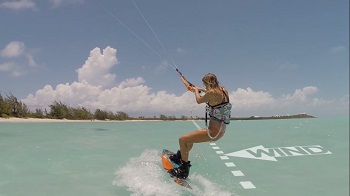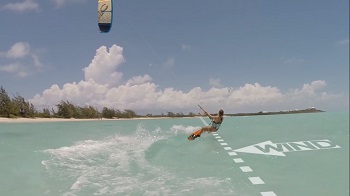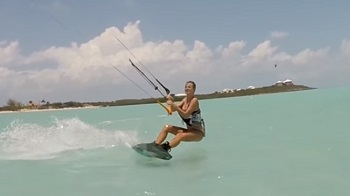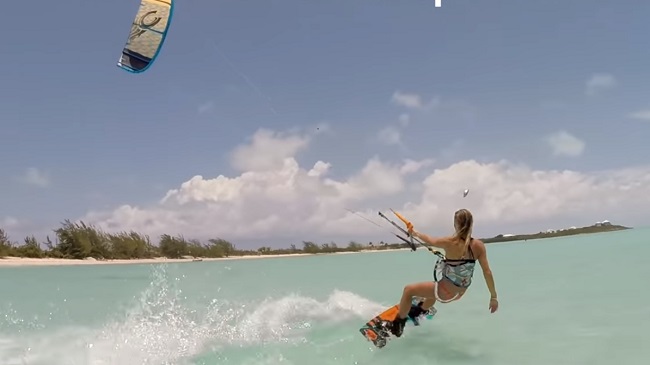After nailing the water start, riding upwind is one thing that a lot of kitesurfing beginners struggle with. But this article will look at how to kitesurf upwind without any difficulty. A few basic technique tips will have you heading upwind with confidence in knowing that you can get back to the same spot on the beach.
As with all my technique articles, this is not designed to replace lessons from a qualified instructor. However, it’s quite normal to have had enough lessons to get you safely on the water but still not have mastered getting upwind.
If you’re anywhere near the North of the United Kingdom, why not check out Northern Kites where you’ll find me teaching alongside the rest of the team whenever the wind is right.
So let’s dive straight in!
There are 4 main things that you need to get right:
-
- Board Speed.
- Kite Control.
- Board Control.
- Stance.
Video Courtesy of Alex at Kitesurf College
Board Speed
The most common mistake beginners make once they’ve mastered the water start is to immediately try to turn upwind. It’s a natural reaction, especially with a directly onshore wind, to want to sail straight away from the beach as soon as you get up.
However, turning immediately upwind will kill your board speed before it’s even started.
As with most things in kitesurfing, speed is your friend. But it has to be controlled speed for riding upwind.
You need to have the board planing before you turn upwind, so that only the heel-side edge of the board is in the water.
So the first tip is to turn downwind first by pointing the front of the board towards the kite. If you’ve just water-started near the beach this is why you need to have started far enough out (in onshore wind) to give you space to go downwind.
But don’t worry, it only takes a few metres of downwind riding to get enough speed. Then you can make a smooth carve at controlled speed towards the wind.
You don’t want too much speed though as this will result in the board barely being in contact with the water. You need to be able to dig the heelside edge into the water to resist the pull of the kite, so you only need medium speed to easily do this.


Kite Control
This is how you control your board speed.
First thing, with very few exceptions you should always have both hands close to the centre line on the bar and with your arms relaxed. In that position you have full control over the sheeting in and out and can also steer the kite with small hand movements.
You can also steer with only one hand on the bar when they’re in this position.
You want the kite positioned around the mid point in the power window, at about 45°. If it’s too low in the window it will be in the highest power zone and will tend to pull you downwind. Too high and you’ll lose speed.
You also need to use the bar to control how much power the kite is generating so that you get a constant amount of power. You’ll very quickly get the feel for this, constantly adjusting the bar position to compensate for gusts or lulls.
And if the wind drops significantly you need to be able to work the kite up and down slightly to generate extra power. This technique creates extra “apparent” wind over the surface of the kite as it dives upwards and downwards. And that extra airflow produces more power in the kite. Exactly like an aircraft wing.
Board Control
As I mentioned earlier, you need to have enough of the heel-side edge of the board digging into the water to resist the sideways pull of the kite, which will be trying to pull you downwind.
The stronger the wind, or the faster the board speed, the more “edge” you will need to dig in. This technique is called “edging”, and in really strong winds you’ll see experienced kiters riding along with the board almost vertical, with the heel-side dug in and the toe-side up.
Edging is also a good technique for controlling board speed if you find yourself overpowered or simply travelling too fast. A sharp turn upwind with the edge dug in will slow the board right down even in overpowered conditions.
You can also use the board to generate more speed if you go too far towards the wind causing a drop in speed, or if the wind drops slightly.
To do this you turn the board back towards the kite and ride downwind again until you have enough speed to carve back upwind.
Stance
Having the right stance will help you with both kite and board control.
Legs
Your front leg should be almost straight, with just a little bend at the knee to absorb any chop or waves. Your back leg should be more bent with it tucked in behind you, and slightly more weight on the back leg to keep the front of the board out of the water a little.
With your legs in these positions you can use your back leg to steer the board either up or downwind.
Hips
A common mistake for beginners is to adopt the “poo-stance”. This is where they have both legs bent and they’re bent at the hips so that they look as though they’re sitting on the toilet. Funny to see but not very cool!

This is not only bad for your back but it also means the kite will be pulling upwards on the harness hook rather than straight out from it. The result is that you aren’t using your full body weight to resist the pull of the kite but rather your backside.
It also causes the harness to ride up which is very uncomfortable.
So you need to have almost straight hips in the up and down axis of your body. You’ll hear instructors yelling “make love to the kite”. This is what they mean – thrust your hips out towards the kite.
With your back straight and hips out, the pull from the kite is directed through your harness directly down to the board.
It takes a bit of confidence at first because the natural defensive position is to crunch up into the poo-stance to avoid being pulled over the front of the board. But once you realise that you’ve got way more control over the power it becomes second-nature.
Upper Body
In a lot of kitesurfing manouevres the truth is that where the head and shoulders point is where the board will go.
So you need to rotate your upper body from the waist to point upwind in the direction you want to go. To help with this, I find that it’s good to pick a point slightly further upwind than I want to go and turn my head and shoulders towards it. Effectively aim at it.
Another great way to help turn your upper body upwind is to drop your front hand from the bar and let it hang loose at your side. This has the effect of throwing your weight backwards and outwards to help direct the board upwind.
If you want to be very cool drop your front hand into the water and make a spray!

Bringing It All Together
No single one of these things will work alone. They all work together to make kitesurfing upwind a natural flow. So if you aren’t nailing it it’s probably because one or more of these techniques isn’t right.
But if you find you’re still struggling to get upwind smoothly just go back to the video as soon as you can after a session and try to pin-point which ones are missing.
Don’t worry, it will soon be as natural as walking, but much more exciting!
I hope this is helpful and, if so, please leave a comment below. Feedback is always welcomed.
And if you have any questions please leave those too. If you do find it helpful, hit the “follow” button and you’ll receive email notification when I publish new articles. Strictly no spam, guaranteed!


Great advice!thanks!
Hi Lohan,
Thanks for your kind comment. I hope it helps!
Cheers
Adrian